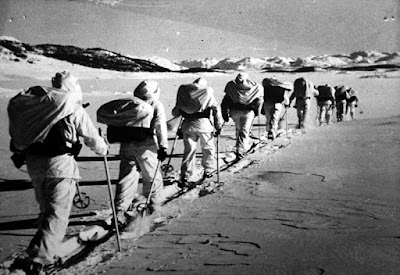Supplies required by the commandos were dropped with them in special CLE containers. (One of these was buried in the snow by a Norwegian patriot to hide it from the Germans; he later recovered it and in August 1976 handed it over to an officer of the (British) Army Air Corps, who were exercising in the area. The container was brought back to England and was displayed in the Airborne Museum at Aldershot. The Museum closed in 2008 and is now part of the Imperial War Museum Duxford).
Following the failed Freshman attempt, the Germans put mines, floodlights, and additional guards around the plant. While the mines and lights remained in place, security of the actual plant had slackened somewhat over the winter months. However, the single 75 m (246 ft 1 in) bridge spanning the deep ravine, 200 m (660 ft) above the River Måne, was fully guarded.
--------------------------------------------------------
28. helmikuuta 1943 kuusi miestä pudotettiin Telemarkiin laskuvarjoilla operaatio Grousen neljän seuraksi. Kymmenen miehen ryhmä taivalsi jäisen rotkon yli tehtaalle. He asensivat räjähteitä, räjäyttivät tehtaan ja pakenivat.
Neljä heistä jäi Norjaan avustamaan vastarintaliikettä, loput kuusi hiihtivät Norjasta 400 kilometrin matkan Ruotsiin vapauteen.
Iskua pidettiin yhtenä toisen maailmansodan uskaliaimmista sabotaaseista. Sen pohjalta tehtiin myöhemmin elokuva Telemarkin sankarit, pääosassa Kirk Douglas.
Räjäytyksen jälkeen saksalaiset päättivät siirtää Saksaan kaiken sen, mitä tehtaasta oli jäljellä, myös raskaan veden. Kuullessaan tästä Norjan vastarintaliikkeen miehet kehittelivät salaisen suunnitelman upottaakseen Hydro-lautan, jonka oli määrä kuljettaa neljään rautatievaunuun lastattu raskas vesi.
20. helmikuuta 1944 lautalle salakuljetettiin pommi. Se räjähti, kun lautta oli ylittämässä Tinnsjöjärveä Tinnissä. Lautan uppoaminen teki lopun natsi-Saksan ydinohjelmasta.
------------------------------------------------------
The explosive charges detonated, destroying the electrolysis chambers.
The raid was considered successful. The entire inventory of heavy water produced during the German occupation, over 500 kg (1,102 lb), was destroyed along with equipment critical to operation of the electrolysis chambers. Although 3,000 German soldiers were dispatched to search the area for the commandos, all of them escaped; five of them skied 400 kilometres to Sweden, two proceeded to Oslo where they assisted Milorg, and four remained in the region for further work with the resistance.
Although this attack did no irreparable damage to the plant, it did stop production for several months. The Vemork plant was restored by April and SOE concluded that a repeat commando raid would be extremely difficult, as German security had been considerably improved.
Almost as soon as production restarted, the USAAF started a series of raids on Vemork. In November, the plant was attacked by a massed daylight bombing raid of 143 B-17 heavy bombers dropping 711 bombs, of which at least 600 missed the plant. The damage, however, was quite extensive.
Then, on November 16 and 18, 35 B-24 heavy bombers from the 392nd Bomber Group of out of Wendling, Station 118, attacked the hydro-electric power station at Rjukan with excellent coverage of the target. These missions were the longest for this bomber group, lasting 9 1/2 and 10 1/2 hours respectively.
The need for ground assaults was reduced from a year earlier as there was now an available alternative of night bombing, which had previously been unrealistic owing to German air cover. The Germans were convinced that air raids would result in further serious "hits", and they decided to abandon the plant and move remaining stocks and critical components to Germany in 1944










Ei kommentteja:
Lähetä kommentti
Any explosive ammunition or empty cores, you can put in this.